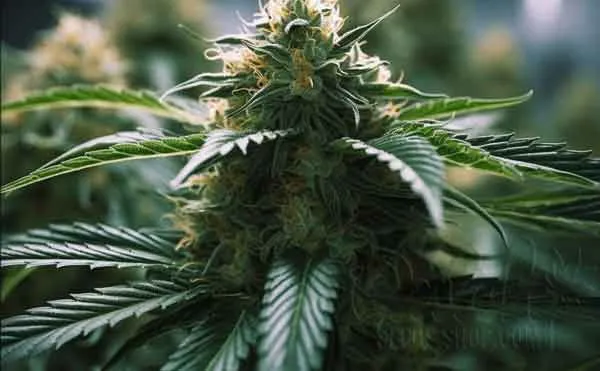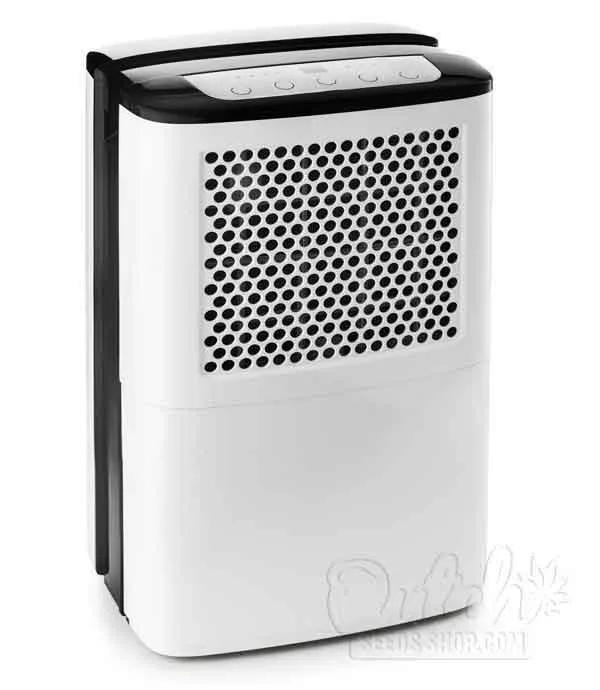Guide To Best Humidity Levels For Growing Cannabis Indoors
You see, my friends, growing weed is like painting a masterpiece – every brushstroke matters, and each detail must harmonize with the others. And humidity? That’s the color palette that brings your plants to life. Now, humidity can be a fickle friend to our beloved cannabis plants. It’s like a tightrope walk – balance is…

The Best Humidity for Indoor Cannabis Plants

Allow me to paint a picture for you – imagine a rainforest, teeming with life and shrouded in mist.
That’s where our cannabis plants feel right at home.
The humidity in the air provides the perfect environment for them to thrive.
And that, my friends, is why we must create an indoor oasis for our precious green companions.
But, like a delicate dance, we must consider many factors that affect the relative humidity levels.
It’s not just about cranking up the relative humidity when growing cannabis and hoping for the best.
We must become like puppet masters, pulling the strings to achieve the perfect balance in our grow rooms.
The importance of level of humidity during different growth stages cannot be overstated.
Each stage is like a chapter in the life of your plant, with unique humidity requirements to ensure their story unfolds beautifully.
Humidity Control in Indoor Cannabis Grow Room

Let’s talk about the unsung hero of indoor weed growing: control of humidity.
It’s like a conductor, orchestrating the symphony of humidity, temperature, and airflow to create the perfect environment for our plants to flourish.
High and low levels of relative humidity can be like a double-edged sword – both can have dire consequences on the well-being of our plants.
Inconsistent humidity is like a roller coaster, sending our plants through a whirlwind of stress and confusion.
Keep the humidity consistent throughout the growing process is up to us, guiding our plants to their fullest potential.
Fear not, for I will share the techniques for controlling humidity, including the tools and methods I’ve collected through years of experience.
Together, we will become masters of the indoor grow room.
Humidity Levels for Different Stages of Cannabis Growing
Ah, the circle of life for cannabis plants – each growth stage has unique humidity requirements.
Let’s embark on a journey through these stages and explore the amount of humidity that your plants need to grow strong and healthy.
Humidity Range for Germination

The germination stage is like the opening scene in the play of your plants lives.
For seeds to sprout, they need a warm, moist environment.
Humidity range of 70-80% is recommended, with a sweet spot of around 75%, to provide the perfect embrace for your tiny seedlings.
Optimal Humidity for Seedlings

As our cannabis seedlings emerge, they’re like little saplings reaching for the sky.
In this early stages, maintaining a relative humidity for seedlings of around 65-70% will help them grow strong and sturdy, preparing them for the adventures that lie ahead.
Proper Humidity for Vegetation Period

During the vegetation grow period, our plants are like teenagers, growing and changing rapidly.
A slightly lower RH of 40-70% will keep them happy and healthy as they stretch their leaves and branches, preparing to bear their beautiful buds.
Perfect Humidity For Flowering Period

Ah, the blooming grow period – the grand finale of our plants performance.
As our plants burst into bloom, maintaining a humidity of around 40-50% will ensure their flowers develop to their full potential, like a firework display of resinous cannabis buds.
Perfect Humidity for Late Flowering Stage

As our plants prepare to take their final bow in the late flowering stage, we must lower the humidity to around 30-40%.
That will help to prevent mold and ensure a bountiful harvest, leaving you with a standing ovation from your plants.
Ideal Humidity For Growing Cannabis Clones
Cloning, my friends, is a magical process where we replicate our favorite weed plants.
Humidity plays a starring role in the cloning process, affecting the overall success rate.
We must be diligent and attentive to the humidity levels during the rooting process for the sake of our little green doppelgängers.
A humidity chart can be your trusty sidekick in this endeavor, guiding you through the twists and turns of humidity for clones.
| Initial Cloning Stage | 70-75% high humidity environment |
| After Roots Appear | Gradually decrease humidity to 60-65% |
| Transplanting into Growing Medium | Adjust humidity to match the requirements of the vegetative stage (50-70%) |
With the chart by your side, you can confidently achieve the perfect environment for your clones to take root and flourish.
Using a Humidity Dome for Marijuana Clones

Picture this: a miniature greenhouse providing a warm, moist haven for your clones.
That, my dear cultivators, is a humidity dome. It’s like a protective bubble, nurturing your clones with the optimal humidity levels they need to grow strong roots.
To use a humidity dome effectively, you must know when to water your clones and when to remove the dome, like a gardener tending to their most prized flowers.
Proper care and maintenance of the humidity dome, such as preventing mold growth, will ensure a healthy environment for your clones to thrive.
For those who prefer to walk the road less traveled, there are alternative methods for maintaining humidity for clones, allowing you to choose the path that suits your unique growing style.
What is Relationship Between Temperature and Humidity
Temperature and RH are intertwined, working together to create an ideal environment for plants. Understanding the relationship between temperature and humidity is essential for successful cultivation:
- Dew Point: The dew point reveals the temperature at which air becomes saturated, and dew forms. This concept illustrates how temp and humidity affect each other.
- Temperature’s Impact on Humidity: When temperature rises, the air holds more moisture, leading to lower RH. When temperature drops, the air holds less moisture, causing higher relative humidity.
- Managing the Duo: Adjust both temp and humidity in your grow room to maintain the perfect balance. For instance, if the temperature is too high and humidity too low, lower the temperature and increase humidity. Conversely, if the temperature is too low and humidity too high, raise the temperature and decrease humidity.
Understanding Vapor Pressure Deficit (VPD)
Enter the world of VPD charts – a realm where RH and temperature unite to create the perfect growing conditions for plants.
With a VPD chart, you can decipher the secrets of optimal humidity for each stage of marijuana growth, from seedling to blooming.
| Seedlings | 0.4 – 0.8 kPa |
| Vegetative Stage | 0.8 – 1.2 kPa |
| Blooming Stage | 1.0 – 1.5 kPa |
Monitoring VPD and humidity regularly is like the compass that ensures your cannabis plants reach their final destination – a bountiful harvest.
Chart for Optimal Weed Growth
Behold, the treasure map of cannabis cultivation!
Below, you’ll find a chart displaying the optimal humidity and temperature levels for each cannabis growth stages: seedling, vegetative, blooming, and late blooming.
Follow this guide to ensure your plants reach their full potential.
| Stage | Seedling | Vegetative | Blooming | Late Blooming |
| Humidity Level | 65-70% | 50-70% | 40-50% | 30-40% |
| Temperature Range | 68-77°F (20-25°C) | 70-85°F (21-29°C) | 65-80°F (18-26°C) | 65-80°F (18-26°C) |
Factors Affecting Relative Humidity Control for Cannabis
In the wondrous world of weed cultivation, a multitude of factors impacts the control of relative humidity for your plants.
Each element, like a diverse cast of characters, plays its part to ensure your plants thrive in harmony.
Let’s explore these factors in more detail:
- Region: The climate of your location influences the ambient humidity. In some areas, humidity might be naturally high, while others have low relative humidity. Understanding your region’s climate helps you make the necessary adjustments to create the ideal growing environment.
- Genetics: Different strains have unique responses to humidity. Indica marijuana strains for example, often prefer lower RH, while sativa strains can tolerate higher RH. Understanding your plant’s genetics will guide you in managing humidity for their specific needs.
- Growth stages: As your plants progress through their life cycle, their humidity requirements change. Adapting your control strategy to suit their evolving needs is crucial. Seedlings and vegetative plants thrive in higher humidity while blooming plants prefer a drier environment.
- Lighting: The lighting you use in your room impacts temperature and, consequently, humidity. For instance, high-intensity discharge (HID) lights produce more heat than LED lights. Adjusting the humidity in response to your lighting setup helps maintain the proper balance.
- Ventilation: Proper airflow in your grow area is vital for controlling RH. Good ventilation helps to remove excess moisture from the air and ensures a consistent environment for your plants. Utilizing fans, vents, and air filters can improve air circulation and maintain the desired humidity.
- Watering frequency: The amount and frequency of watering your plants can impact humidity. Overwatering can lead to high humidity levels, while underwatering may result in low humidity. Finding the right balance is crucial to create the optimal environment for your plants.
- pH and EC levels: Maintaining proper pH and EC levels is essential for nutrient uptake in your plants. Imbalances in these levels can cause nutrient deficiencies or toxicities, which may affect the plant’s overall health and growth, ultimately influencing humidity management.
Adjusting Proper Humidity Levels
As the maestro of your grow space, you must know when to increase or decrease humidity to keep your plants in harmony.
Temperature also plays a role in this delicate balance, so understanding how to control both is essential.
Ways to Lower Humidity

When it’s time to bring the humidity down, consider these tools in your arsenal:
- Ventilation, like a gentle breeze flowing through your grow area
- Dehumidifiers, the superheroes of moisture control
- Air conditioning, a cool friend that helps maintain the perfect environment
Ways to Raise Humidity

Should you need to elevate humidity, these trusty sidekicks can assist:
- Humidifiers, the champions of moisture
- Water trays, a simple yet effective method
- Wet towels, like a comforting hug for your plants
Signs of Poor Humidity Management
Detecting poor management in your grow area is like being a plant detective, searching for clues that something’s amiss.
Unraveling the mystery can prevent potential disasters, ensuring your plants’ health and growth.
Keep an eye out for these telltale symptoms:
- White Powdery Mildew (WPM): This fungal villain appears as a white, powdery substance on your plants leaves. High relative humidity provides the perfect breeding ground for WPM, which can spread quickly and cause severe damage.
- Bud Mold/Rot: Excessive humidity can lead to mold and rot, especially during the blooming stage. Moldy buds are a cannabis growers nightmare and can render an entire harvest unusable.
- Nutrient Issues: Poor management can disrupt your plants ability to absorb nutrients, leading to deficiencies or toxicities. These nutrient problems can manifest as discolored or wilted leaves and slow growth.
- Reduced Growth: Both high and low levels can stunt your plants growth. Excess humidity can cause poor root development and increased susceptibility to pests and diseases, while low humidity can lead to dehydration and reduced nutrient uptake.
FAQ
What is the recommended humidity for drying and curing cannabis?
The recommended humidity for drying cannabis is between 45-55%, and for curing cannabis is around 60-65%.
Why is proper humidity crucial for cannabis health and yield?
Proper humidity is crucial for cannabis health and yield because it impacts nutrient uptake, photosynthesis, and overall plant growth.
How can I adjust humidity levels in my indoor grow space?
To adjust humidity levels in your indoor grow space, use a humidifier to increase humidity and a dehumidifier to decrease it.
About the Author
Share the Love:
